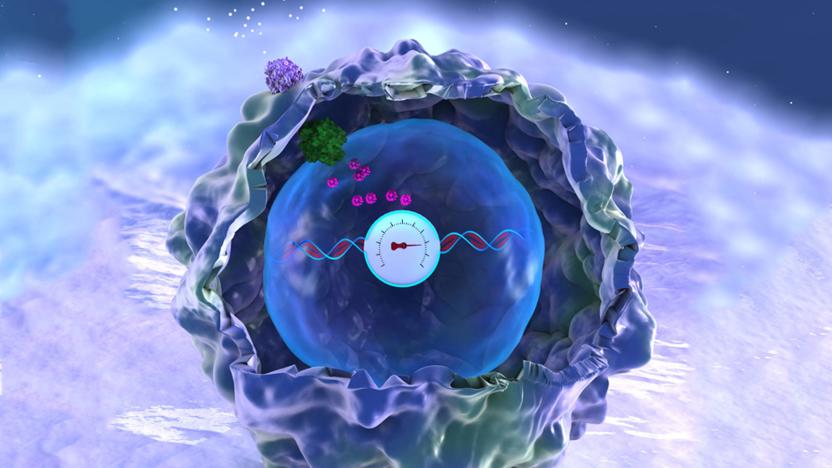history
Latest

'Assassin's Creed Origins' adds history lessons in early 2018
The Assassin's Creed games have always had an element of historical realism to them, but it's hard to appreciate that cultural authenticity when you're five seconds away from being stabbed by a Templar. Thankfully, Ubisoft will take the pressure off for Assassin's Creed Origins players. It's adding a Discovery Tour mode devoted solely to giving you history lessons. There are "dozens" of guided tours led by Egyptologists and historians, focusing on subjects like the Great Pyramids (naturally), Cleopatra and mummification. And importantly, you're free to explore on your own terms without combat or plot getting in the way.

Recommended Reading: Hollywood is really mad at Rotten Tomatoes
Attacked by Rotten Tomatoes Brooks Barnes, The New York Times The film scores tallied by Rotten Tomatoes are what many moviegoers use to decide how to spend their money. As you might expect, this doesn't make some folks in Hollywood too happy. In fact, they're pretty darn upset. Some claim low scores on Rotten Tomatoes cost big name films like Baywatch and King Arthur: Legend of the Sword millions this summer. The New York Times takes a look at the rift the movie ratings site has created with its Tomatometer. I'd argue studios should stop blaming a website and just start making better movies, but what do I know.

Microsoft co-founder's remote vehicles find a legendary WWII ship
The USS Indianapolis played an important role in WWII history, including the delivery of parts for the atomic bombs that would eventually drop on Japan. However, it met a grim fate: not only did a Japanese submarine sink it near the end of the war, but its wreck has remained elusive despite multiple expeditions over the past 72 years. Technology just provided some resolution, though. A team piloting Microsoft co-founder Paul Allen's research vessel, the R/V Petrel, has found the wreck of the Indianapolis at the bottom of the Philippine Sea. The discovery was helped by a mix of better information and the equipment aboard the Petrel itself.

Library of Congress archives select webcomics for posterity
Webcomics have been around for a long while, and that's raising a question: who's going to preserve those comics for online viewing outside of non-profits like the Internet Archive? The Library of Congress, that's who. It just launched a Webcomics Web Archive that curates stand-out strips. Many of them are award-winning or otherwise stand-out comics that you may have read -- the nerdiness of XKCD and the historical spoofs of Hark! A Vagrant are among the initial batch.

DNA in dirt can reveal where human ancestors lived
When you want to know where humans have lived, you typically look for direct signs like bones or buildings. But that's not always easy, especially with hominid ancestors who didn't exactly leave an abundance of remains. Thanks to a new genetic research technique, however, those obvious clues won't be necessary -- you'll just need some dirt. Scientists have discovered that they can obtain ancient DNA from soil by effectively luring it out and creating matches.

Non-profit aims to preserve the hidden history of video games
It's relatively easy for developers to preserve classic video games through emulators, museums, remasters and retro consoles. But what about the culture that surrounded it, such as ads, boxes, magazines and gamers' own experiences? That's where the newly established Video Game History Foundation wants to help. The non-profit hopes to collect and digitize as many video game artifacts as possible to understand the full context of a game or console. For instance, it's building an NES USA Launch Collection that covers the atmosphere surrounding Nintendo's American debut, including the company's sales pitch as it reassured retailers burned by the video game industry crash.

Google opens massive virtual collection of US presidential history
If you're an American history buff, you're in luck. To celebrate President's Day, Google arts and culture team has just kicked off a monumental historical project focusing on our country's top office with the American Democracy program.

12 million declassified CIA files are now available online
The CIA has posted a vast cache of nearly 12 million declassified CIA pages online, including info on Nazi war crimes, the Cuban Missile Crisis, UFO sightings, human telepathy ("Project Stargate") and much more. It's been a long time coming -- Bill Clinton first ordered all documents at least 25 years old with "historical value" to be declassified in 1995. The agency complied, but didn't exactly make it easy to see the trove -- you had to trek all the way to the US National Archives in Washington DC to get a peek.

James Cameron producing history of sci-fi series for AMC
AMC is producing a six-part series on the history of science fiction in collaboration with one of its most prolific modern purveyors, James Cameron. Tentatively titled James Cameron's Story of Science Fiction, it will examine the history of science fiction from the early days of H. G. Wells and Jules Verne to the pop-culture juggernaut it is today. "When I was a kid, I basically read any book with a spaceship on the cover and I saw 2001: A Space Odyssey many, many times," Cameron said in a statement

Researchers digitally reconstruct the face of a legendary Scottish king
Robert the Bruce, a medieval warrior and hero-king of the Scottish people, is something of an enigma. While his exploits in battle against both domestic rivals and British occupiers have been well-documented, descriptions of his physical appearance have long been lost to history. But thanks to a collaborative effort between researchers at the University of Glasgow and Liverpool John Moores University (LJMU), we may finally know what he looked like.

Netflix's 'White Rabbit Project' looks like 'Mythbusters 2.0'
White Rabbit Project isn't an official continuation of the Mythbusters franchise, but it's pretty darn close. The show stars former Mythbusters members Kari Byron, Tory Belleci and Grant Imahara, and it's set to premiere on Netflix on December 9th. This time around, Byron, Belleci and Imahara aren't just investigating strange scientific phenomena or seemingly impossible movie scenes; they're ranking history's weirdest inventions, heists and happenings, and seeing how science makes them possible.

Get a look at the lost Super NES 'Rayman' game
When he isn't busy cryptically teasing Beyond Good & Evil 2, game developer Michel Ancel laments (above) past projects lost to the sands of time. Like the Super NES version of Rayman that was scrapped in favor of iterations for the Atari Jaguar and original PlayStation. As noticed by Motherboard, Ancel managed to find an old prototype cartridge and fired it up.

US National Archives gets into the historical GIF game
The National Archives and Records Administration (NARA) serves as America's historian, cataloging and preserving the nation's most precious documents, audio and video recordings. On Thursday, NARA announced that it had launched a Giphy channel with more than 150 animations to help showcase its vast trove of video content. The administration plans to expand upon that figure with an eclectic mix of classic footage. via GIPHY What's more, every GIF automatically links back to the archive's website which includes additional information on the significance of the piece. The Bugs Bunny gif above, for example, is actually from short titled "Uncle Sam Speaks" and is actually a compilation of savings bond promotions.

Scientists use 3D scans to 'unwrap' an ancient scroll
The scientific world is developing a knack for reading texts without opening them. Researchers in Israel and the US have conducted the first "virtual unwrapping" of a heavily damaged scroll, the En-Gedi scroll, to read its contents without destroying what's left. The team used a high-resolution volumetric scan to create a 3D model of the scroll, looked for bright pixels in the model (a sign of where the ink would be) and virtually flattened the scroll to make text segments readable.

MIT uses radiation to read closed books
There are some books that are simply too delicate to crack open -- the last thing you want to do is destroy an ornate medieval Bible simply because you're curious about its contents. If MIT has its way, though, you won't have to stay away. Its scientists have crafted a computational imaging system that can read the individual pages of a book while it's closed. Their technology scans a book using terahertz radiation, and relies on the tiny, 20-micrometer air gaps between pages to identify and scan those pages one by one. A letter interpretation algorithm (of the sort that can defeat captchas) helps make sense of any distorted or incomplete text.

3D models offer a detailed look at Mary Rose artefacts
In 1545, the Mary Rose warship drifted to the bottom of the Solent, a slither of sea that separates the Isle of Wight from mainland England. It was rediscovered in 1971 and carefully salvaged in 1982, triggering a major preservation project in the city of Portsmouth. Now, you can examine some of the vessel's remains -- including the skull of a thirty-something carpenter -- in your browser, for free. The 3D models are part of a project called Virtual Tudors, which hopes to challenge the long-held belief that osteological bone examinations need to be conducted in person.

Gene editing records 'memories' in human DNA
Scientists have been recording data in DNA for a while, but it has usually involved bacteria and other simple organisms. MIT, however, just took a big leap forward. Its researchers have used the CRISPR gene editing technique to record histories in human cell DNA for the first time. They've crafted a gene circuit that only expresses an enzyme when it's near a key immune cell molecule, building up mutations the more it's exposed to that molecule. All you have to do to extract "memories" is to sequence those genes. They'll tell you whether or not there was a lot of inflammation, for instance.

ICYMI: Studying the 1700's clouds for pollution clues
try{document.getElementById("aol-cms-player-1").style.display="none";}catch(e){}Today on In Case You Missed It: Scientists at CERN constructed a large chamber to replicate the cloud environment before the world's Industrial Revolution got its start after 1750. The thought had been that there were far fewer clouds on Earth then, but already results are pointing to a different reality that could help guide present day modeling of global climate change. If you want to take a peek at the continent colonizing study showing we were taught lies in history class, that's here. The toaster of your five-year-old's dreams? That's here. As always, please share any interesting tech or science videos you find by using the #ICYMI hashtag on Twitter for @mskerryd.

The first website went public 25 years ago
The internet just marked another major milestone. The first website, Tim Berners-Lee's description of the World Wide Web project, went public 25 years ago on August 6th, 1991. The launch was unceremonious -- Berners-Lee announced the project on a Usenet group, and it wasn't until after August 23rd that new users visited the site. However, the launch effectively marked the start of the web as a widely available tool.

Museum uses 'Minecraft' to visualise the Great Fire of London
Minecraft and its 'build what you want' mentality has made it an effective tool in the classroom. The game, developed by Mojang and owned by Microsoft, has been used to teach art, geology and now history, thanks to a new project by the Museum of London. It's called "Great Fire 1666" and will portray the historic blaze that swept across the city 350 years ago.








